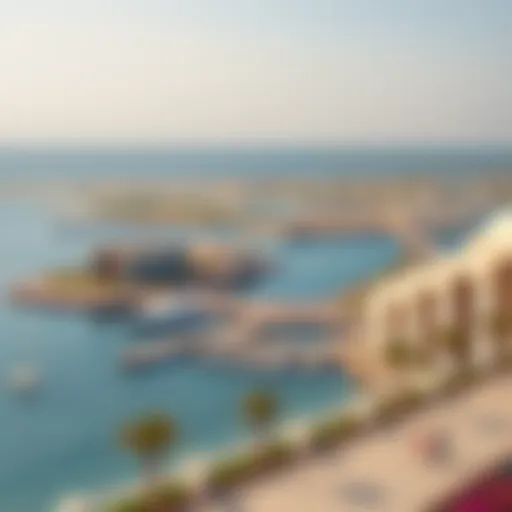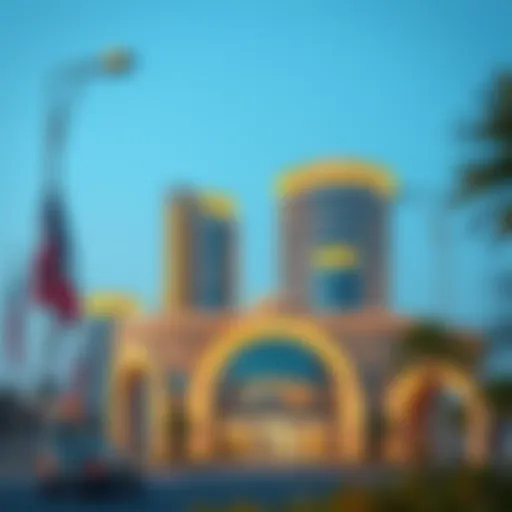Exploring Green Community Developments in Dubai
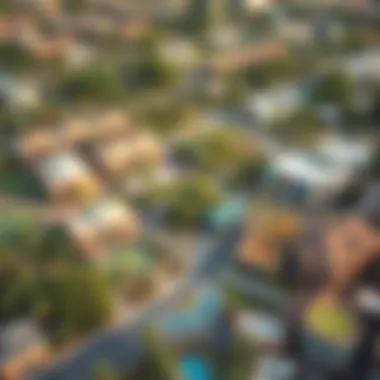

Intro
Dubai is more than just a shimmering skyline and luxury shopping; it's an evolving metropolis that increasingly champions sustainability. With the shift towards a greener urban vision, the concept of green community developments emerges as a response to both environmental and social challenges. As the city grows, so does the necessity for developments that promote sustainable living practices. This article sheds light on what these green developments entail, their importance in the current context of Dubai’s economy, and how potential investors, buyers, and residents can benefit from them.
In these green communities, the principles of sustainability are brought to life through the design and operation of residential and commercial spaces. It’s not merely about lush parks and energy-efficient buildings; it encompasses an entire ecosystem focusing on reducing carbon footprints, fostering a sense of community, and enhancing overall quality of life. From savvy investors looking for promising opportunities to families seeking eco-friendly living spaces, there’s something for everyone interested in the green wave sweeping through Dubai.
August 2023 marked a pivotal moment in the Real Estate sector with the introduction of strategic regulations aimed at enhancing the impact of sustainability on property values. As we delve further into this topic, a clear picture of the economic foundations, investment opportunities, and community benefits associated with green living will unfold, providing a roadmap for understanding its relevance in today’s real estate landscape.
Market Insights
Current Trends in Dubai Real Estate
Dubai's real estate market has been experiencing a shift towards more eco-conscious developments. A growing number of buyers are showing preference for properties that integrate sustainable features. Projects like the Sustainable City contribute to this trend by showcasing energy-saving technologies, solar power, and enhanced green spaces. Furthermore, developers who embrace eco-friendly practices are seeing an increase in demand as more individuals prioritize sustainability in their lifestyle choices.
Economic Factors Impacting Property Values
The economic climate in Dubai is continuously evolving. With government support for eco-friendly initiatives, property values in green developments often see a boost. Factors influencing these values include:
- Sustainable certifications: Properties that meet certain environmental standards tend to sell at higher prices.
- Government incentives: Tax benefits and grants for sustainable projects can significantly influence investment decisions.
- Community engagement: Properties in areas with strong community initiatives see a rise in desirability.
The intersection of sustainability and economic growth presents a unique investment opportunity for those willing to navigate these waters carefully. As the focus shifts towards preserving the environment, understanding the nuances of Dubai's real estate landscape becomes essential for making informed decisions.
Understanding Green Community Concepts
Understanding the concept of green communities is crucial, especially in the bustling and rapidly evolving urban landscape of Dubai. These communities aim not only to address environmental concerns but also to enhance the quality of life for residents. This section delves into the definition of green communities, their core principles, and how they've evolved over time, providing a solid foundation for the discourse that follows.
Definition and Key Principles
Green communities can be defined as neighborhoods designed with sustainability at their core. They integrate eco-friendly practices into everyday living, emphasizing energy efficiency, waste reduction, and enhanced biodiversity. Key principles include:
- Sustainable Design: Buildings and landscapes that minimize environmental impact while providing functional living spaces.
- Resource Efficiency: These communities adopt practices such as rainwater harvesting and energy-efficient appliances to reduce resource consumption.
- Community Engagement: Involving residents in decision-making processes to foster a sense of ownership and responsibility towards the environment.
- Accessibility: Ensuring that all community members have access to green spaces, public transport, and daily amenities, while reducing reliance on cars.
The significance of these principles is profound. They not only contribute to a healthier environment but also cultivate a vibrant community spirit. By fostering interaction among residents, green communities create spaces that feel welcoming and supportive, laying the groundwork for resilient neighborhoods.
Historical Evolution of Green Communities
The historical trajectory of green communities reveals their increasing relevance in urban planning. Initially, the concept emerged in response to the industrial revolution and the subsequent environmental deterioration that followed. In the late 20th century, with rising awareness of environmental degradation, the push for sustainable living gained momentum.
In Dubai, this shift is particularly noteworthy. The government recognized the need to balance rapid urbanization with sustainable practices. Various initiatives and regulations have been introduced since the early 2000s to encourage environmentally friendly developments. For instance, the introduction of Dubai's Green Building Regulations in 2014 marked a significant turning point; these regulations require developers to adhere to stringent sustainability criteria.
Moreover, the rise of eco-focused real estate, such as developments that harness solar energy and reduce water usage, reflects a broader acceptance of green practices. Residents and developers alike have begun to see the tangible benefits of these lifestyles, making green communities not just a trend but a vital part of Dubai’s urban identity.
Green community initiatives in Dubai show how the future can be both sustainable and inviting. Investing in these areas not only supports environmental goals but also aligns with a lifestyle that values balance, comfort, and sustainability. In subsequent sections, we will explore the myriad benefits these communities offer, along with specific projects shaping the landscape.
Benefits of Living in Green Communities
Living in green communities presents a plethora of advantages that extend far beyond just aesthetics and environmental concerns. It’s about creating a lifestyle that harmonizes with nature, fosters community spirit, and offers substantial economic benefits. As Dubai continues to expand and modernize, these green developments are pivotal in addressing urban challenges while also enhancing the quality of life for residents.
Environmental Advantages
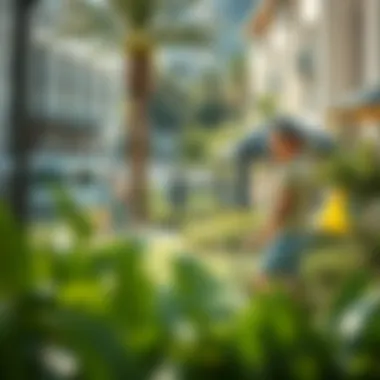

Green communities are designed with the environment in mind, promoting sustainability and reducing the ecological footprint. Key environmental advantages include:
- Biodiversity Preservation: These communities provide habitats for numerous species, encouraging biodiversity. They often feature green roofs, parks, and gardens that not only improve the landscape but also act as essential habitats for urban wildlife.
- Reduced Carbon Emissions: By implementing eco-friendly building practices and materials, these developments contribute significantly to lowering carbon emissions. For instance, the use of natural ventilation systems and energy-efficient appliances helps in minimizing the reliance on fossil fuels.
- Waste Management Strategies: Many green communities adopt comprehensive waste management systems that focus on reducing waste at the source. Residents often have access to recycling programs and composting options, which promote sustainable habits.
"Living in a green community is not just a choice; it's an investment in the planet for future generations."
Economic Implications for Investors
Investing in green communities can yield high returns due to several factors:
- Increased Property Value: Properties within green communities often see enhanced market value. The environmental consciousness associated with these developments attracts discerning buyers who are willing to pay a premium for sustainable living.
- Government Incentives: In Dubai, various government initiatives provide financial incentives for green developments. Investors can benefit from reduced taxes and grants aimed at encouraging eco-friendly construction.
- Cost Savings on Utilities: Sustainability often translates to efficiency, meaning lower utility bills for residents. Energy-efficient systems reduce monthly expenses, making living in these communities increasingly attractive.
Health and Wellbeing Considerations
Living in a green community positively affects residents' health and well-being through numerous channels:
- Access to Green Spaces: Proximity to parks and natural areas encourages physical activity. Studies have shown that access to green spaces contributes to mental well-being, reducing stress and enhancing overall quality of life.
- Quality of Air: Green developments often incorporate trees and plants which improve air quality. This is crucial in urban areas where pollution can be an issue. Cleaner air leads to better respiratory health for residents.
- Community Engagement: These environments foster social connections among residents, which is vital for mental health. Engaging in community activities, such as gardening or environmental initiatives, can create a strong sense of belonging.
In summary, the benefits of living in green communities in Dubai highlight their importance not only for individual well-being but also for the broader environmental and economic landscape. The advantages extend far and wide, making these developments an appealing choice for investors and residents alike.
Key Green Community Initiatives in Dubai
Green community initiatives in Dubai are pivotal in shaping a sustainable future. These projects are not just about creating environmentally friendly spaces; they are instrumental in enhancing the overall quality of life for residents and boosting the economy. While traditional urban developments have often neglected sustainable practices, Dubai is increasingly prioritizing eco-friendliness in its urban planning and infrastructure development. Below are the key initiatives that exemplify this forward-thinking approach.
Sustainable Infrastructure Developments
Sustainable infrastructure developments form the backbone of Dubai's green alternatives. These projects emphasize the integration of natural elements into community designs, promoting harmony between urban life and nature. For instance, community parks and green spaces, like those in Al Barsha, have been designed not only to be aesthetic but also functional, contributing to biodiversity. The use of local plants minimizes water usage and maintenance costs.
Moreover, the incorporation of smart waste management systems helps residents reduce waste generation while facilitating recycling and composting efforts. Ultimately, these infrastructures are vital as they provide residents with access to nature and a healthier environment while also laying down a solid foundation for long-term sustainability.
Renewable Energy Utilization
Utilizing renewable energy is a cornerstone of Dubai's green communities. Many new developments are designed with solar power in mind, significantly reducing reliance on fossil fuels. Such as the widespread installation of solar panels in places like The Sustainable City made a considerable impact, transforming the energy landscape within residential areas. Providing clean energy options leads to decreased utility bills for residents and helps the environment by lowering carbon footprints.
This approach is coupled with incentives from the government, promoting investment in renewable technologies. Innovative setups like energy-efficient lighting and smart meters further bolster these efforts, giving residents insights into their consumption patterns, encouraging them to adopt energy-saving habits.
Water Conservation Techniques
Dubai's arid climate makes water conservation techniques critical in green community developments. Initiatives like rainwater harvesting systems and greywater recycling are now standard practice in many communities. For example, many homes in Dubai are outfitted with systems that collect and store rainwater for irrigation purposes. On top of that, community gardens are designed to utilize drip irrigation, which dramatically cuts down water consumption compared to traditional watering methods.
The emphasis on smart landscaping further complements these water-saving measures. By selecting drought-resistant plants, developers minimize the need for irrigation. This not only conserves water but creates lush, green spaces that enhance the beauty of the community.
"Water is life, and conserving it is an essential part of creating sustainable homes in Dubai."
In summary, the green community initiatives in Dubai serve as a model of how urban development can align with environmental stewardship. By investing in sustainable infrastructure, renewable energy, and innovative water conservation techniques, Dubai is not only advancing its green ambitions but also setting a standard for future developments around the globe. Residents and investors alike can expect that such initiatives enhance property values and contribute to a healthier and more sustainable living environment.
Regulatory Framework Supporting Green Communities
The establishment of green communities in Dubai hinges significantly on a robust regulatory framework. This framework serves as the backbone, ensuring that eco-friendly initiatives are not just theoretical but practically integrated into the fabric of urban development. By aligning with sustainability goals, regulatory measures facilitate the transition towards greener living environments. This is essential for not only improving the quality of life but also for safeguarding natural resources and mitigating environmental degradation.
A well-structured regulatory approach contributes to various elements in supporting green communities. First and foremost, it sets the standards for construction and infrastructure, ensuring that developers adhere to principles of sustainability. This approach helps maintain uniformity and compliance while encouraging innovation in green design and eco-friendly practices.
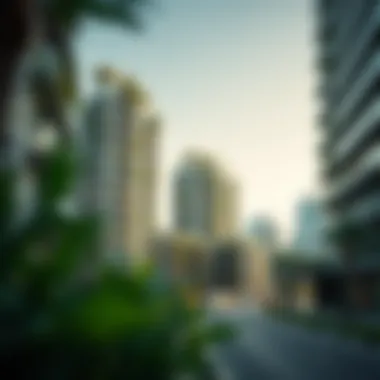
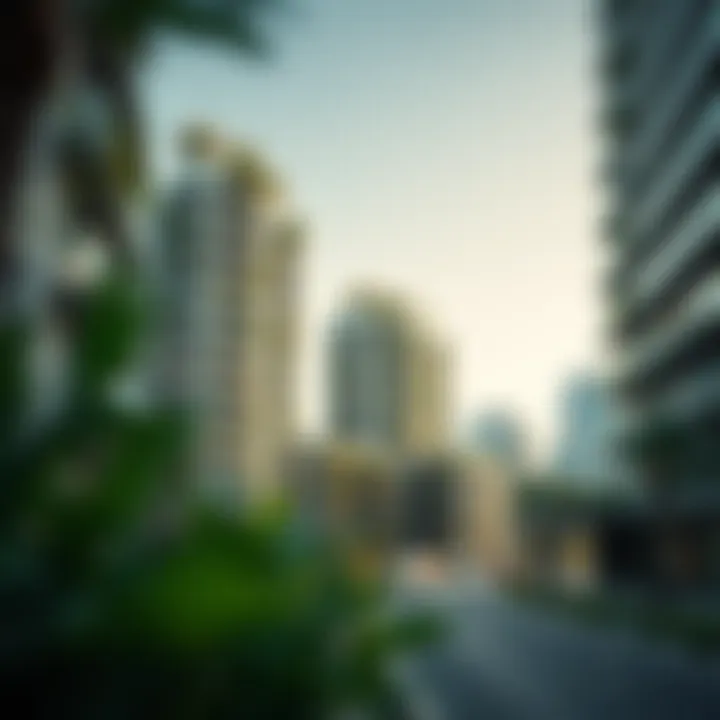
Government Policies and Initiatives
The Dubai government has rolled out a significant number of initiatives aimed at promoting sustainable living. Among these, the Dubai Sustainable City project stands out as a hallmark of commitment to green principles. This initiative embodies the integration of renewable energy sources and promotes reduction in carbon footprint across various sectors.
Additional policies, such as the Dubai Clean Energy Strategy 2050, outline clear targets for increasing the share of clean energy in the emirate. This strategy is designed to shape the future of energy consumption, steering it toward more sustainable and renewable sources. By prioritizing such policies, Dubai’s authorities ensure that comprehensive plans support the growth of green communities through well-defined guidelines.
Another critical aspect is the Smart Dubai Initiative, which aims to transform the emirate into a smart city by embracing technology. This initiative not only aims to enhance living conditions but also focuses on optimizing resource use, thereby promoting a healthier ecosystem.
Building Regulations and Compliance
Building regulations in Dubai have evolved to incorporate green building practices, directly reflecting the shift towards sustainability. For example, the Dubai Green Building Regulations and Specifications set key guidelines for developers, encouraging the use of sustainable materials and energy-efficient systems. Compliance with these regulations is pivotal, influencing aspects such as water conservation, energy efficiency, and indoor air quality.
- Energy Efficiency Standards: Developers must incorporate energy-efficient systems, such as photovoltaic panels or energy-saving appliances, to meet mandatory requirements. This not only reduces operational costs but also fosters a more sustainable environment.
- Water Management Practices: Regulations that enforce water-efficient fixtures and rainwater harvesting systems are essential. These measures contribute significantly to preserving the precious water resources vital for the region.
- Indoor Environment Quality: Building standards ensure that new developments provide adequate ventilation, natural lighting, and reduced indoor pollutants. This focus on indoor comfort enhances residents' wellbeing.
The enforcement of such regulations is crucial. Regular inspections and compliance assessments ensure that the sustainability standards are met over time. This not only protects the investment of the stakeholders but also builds trust within the community that sustainability is taken seriously.
As green communities evolve, the regulatory framework will undoubtedly continue to play a vital role in shaping Dubai’s urban landscape, making it a benchmark for sustainable living in the region and beyond.
Prominent Green Community Projects in Dubai
Dubai’s landscape is rapidly changing, and at the heart of this transformation are its prominent green community projects. These developments stand as a testament to the city's commitment to sustainability while offering an array of benefits like enhanced quality of life, economic growth, and environmental stewardship. Each project not only emphasizes eco-friendly living but also integrates innovative designs that resonate with residents' desires for community, luxury, and sustainability.
Arabian Ranches and its Sustainability Efforts
Arabian Ranches is more than just a residential area; it’s an embodiment of sustainable living in the heart of the desert. The community emphasizes green spaces, featuring lush parks, landscaped gardens, and walking trails that encourage a connection with nature. By utilizing advanced irrigation techniques, such as drip irrigation and recycled water for landscaping, Arabian Ranches showcases how careful planning can reduce water waste in a region where resources are precious.
In addition, the community promotes environmental responsibility through initiatives that encourage recycling and waste reduction. For residents, it's about adopting a lifestyle where sustainability becomes a natural part of their everyday activities. The emphasis on communal areas not only enhances social interaction but also fosters a sense of belonging among residents, which is essential for building a strong community.
The Sustainable City: A Model for Future Developments
The Sustainable City is perhaps one of the flagship examples of environmental innovation in Dubai. This community is designed around the idea of zero carbon living, where every element encourages sustainable practices. Solar panels adorn rooftops, providing clean energy, while electric vehicle charging stations support eco-friendly transportation. Moreover, the integration of urban farms allows residents to grow their own food, significantly reducing their carbon footprint.
Water management in The Sustainable City is also noteworthy. Systems to treat and reuse wastewater are in place, allowing the community to thrive while conserving precious resources. The design promotes walkability and cycling, encouraging a lifestyle that minimizes reliance on fossil fuels.
Ultimately, The Sustainable City serves as a blueprint for future developments aiming for sustainability, proving that luxury can coexist with environmental responsibility.
Madinat Jumeirah Living: A Blend of Luxury and Eco-friendliness
Madinat Jumeirah Living stands out for its effective melding of luxury and eco-conscious design. The project focuses on creating a thriving community infused with cultural heritage, providing not just homes but a lifestyle steeped in traditional Arab architecture while embracing modern sustainability principles.
The layout promotes natural ventilation and the use of daylight through strategically designed windows and open spaces. The extensive landscaping incorporates native plants that require less water, aligning with Dubai’s broader water conservation goals. This approach not only enhances aesthetic appeal but also fosters biodiversity, establishing habitats for local wildlife.
Moreover, Madinat Jumeirah Living is complemented by a network of walking paths and leisure amenities, ensuring that residents have access to green spaces and recreational areas without compromising on comfort. Balancing sustainable features with luxurious living, this development shows that one need not sacrifice comfort for eco-consciousness.
"Sustainable living isn't just an option; it's becoming the norm in urban developments, showcasing how luxury and environmental concerns can harmoniously coexist."
Community Engagement and Awareness
Community engagement and awareness are pivotal in fostering resilient and sustainable urban environments, particularly in green communities. These principles underline the idea that creating eco-friendly neighborhoods is not solely the responsibility of developers or governments; rather, it’s a shared endeavor involving every resident. By actively participating in sustainability efforts, residents can enhance the quality of life and ensure the longevity of green initiatives.


Role of Residents in Sustainable Practices
Residents are the backbone of any community, and in the context of green developments, their involvement is crucial. When individuals take charge of sustainable practices, the impact is magnified.
- Adopting Sustainable Lifestyles: Small changes can make a big difference. Residents can embrace practices like composting, reducing waste, and conserving water. These actions, while seemingly minor, contribute significantly to the overall sustainability of the community.
- Educational Outreach: Engaging in educational programs about sustainability helps raise awareness. Residents can hold workshops and seminars to educate one another on effective practices, such as energy conservation techniques or the benefits of using public transport over personal vehicles.
- Community Monitoring: By forming committees, residents can regularly assess community activities, ensuring that sustainability goals are met and identifying areas for improvement. This kind of hands-on approach leads to a greater sense of ownership and investment in the community’s success.
"Community involvement is the true measure of any project's success — without it, you might as well be building castles in the sand."
Initiatives for Community Participation
Creating an atmosphere where residents feel empowered to participate is key. Initiatives that encourage communal involvement can take various forms, each tailored to meet the unique dynamics of a community:
- Workshops and Events: Organizing local events, ranging from tree-planting days to green fairs, facilitates not just education but also builds camaraderie among residents. These gatherings can serve as a platform for sharing sustainable practices and showcasing projects.
- Incentivizing Participation: Some communities offer rewards or recognition for residents who exemplify green living. For instance, a “Green Citizen of the Month” program can motivate others to follow suit. Financial incentives, like discounts on municipal services for consistent recyclers, can also spur engagement.
- Online Platforms: Leveraging social media groups or community forums can facilitate ongoing conversations about sustainability. These platforms can share resources, discuss challenges, and celebrate achievements, making sustainability a collective journey.
In summary, community engagement and awareness are ar essential components for the success of green developments in Dubai. By encouraging resident participation in sustainable practices and creating engaging initiatives, these communities not only thrive but also inspire similar projects across the region.
Future Prospects of Green Community Developments
Innovation in Eco-friendly Technologies
With the world leaning toward sustainable living, the spotlight is on innovation in eco-friendly technologies. In Dubai, various projects are spearheading efforts to incorporate advanced technologies that minimize environmental impact while maximizing comfort and efficiency.
Solar panels are increasingly taking center stage in these developments, helping to harness the abundant sunlight Dubai receives year-round. This not only reduces reliance on fossil fuels but also lowers energy costs for residents. Other technologies include smart home systems that optimize energy use through real-time monitoring, allowing homeowners to adjust their consumption habits.
Moreover, water purification systems integrated into community infrastructure highlight the commitment to conserving one of the planet’s most precious resources. Technologies like greywater recycling systems allow recycled water to be used for irrigation and flushing toilets, promoting sustainable water use practices.
“Innovation in eco-friendly technologies is not just a trend; it’s a necessity for the future viability of urban areas.”
The integration of electric vehicle (EV) charging stations within community plans also demonstrates a foresight into the eco-aware transportation needs of future residents, making it easier for families to adopt greener mobility habits.
Potential Growth Areas in Dubai’s Real Estate Sector
As the trend toward sustainable living gains traction, certain hotspots in Dubai's real estate sector appear ripe for investment. These growth areas not only reflect current demand but also present unique opportunities for investors looking to tap into the green community movement.
Dubai South, for instance, has seen several green projects take root, underpinning its vision of a sustainable urban living space. This area is gradually becoming a model for others, merging commercial viability with environmental responsibility.
Another area gaining momentum is Dubai Marina, where luxury properties are increasingly incorporating bio-design principles and sustainable materials. The demand for eco-friendly living spaces in this vicinity indicates a shift in buyer preferences, suggesting that investing in such developments can yield fruitful returns.
Lastly, initiatives focusing on affordable housing with green features are also making splashes, appealing to a broader demographic. These projects not only meet housing needs but also tap into the rising consciousness about environmental stability among potential homeowners.
Finale: Navigating the Green Community Landscape
As Dubai moves into a new era of urbanization, green community developments stand as beacons of innovation and sustainability. This conclusion wraps up key discussions surrounding the shaping of green neighborhoods, highlighting their impact not only on the environment but also on the economy and society at large. The sustainable living practices adopted in these communities represent more than just a trend; they embody a commitment to the future—one where residents can enjoy a higher quality of life amidst lush greenery and modern amenities.
Summary of Key Insights
Throughout the article, various critical components of green communities have been unveiled:
- Holistic Benefits: Living in green communities in Dubai yields significant environmental advantages, from reduced carbon footprints to enhanced biodiversity. Inhabitants enjoy cleaner air and more green spaces, which can elevate overall well-being.
- Economic Value: For investors, such developments often lead to higher property values. Facilities and infrastructure designed with sustainability in mind attract more buyers and tenants, having a positive ripple effect on local investment dynamics.
- Regulatory Support: Government initiatives enforcing stringent building regulations promote eco-friendly practices, ensuring that development goes hand-in-hand with environmental consciousness. This regulatory framework fosters compliance and helps maintain standards across the industry.
- Community Engagement: The role of residents in fostering a culture of sustainability is paramount. Initiatives to involve residents in environmental programs or community decision-making processes enhance engagement and strengthen the bond between individuals and their neighborhoods.
As we consider the above aspects, one can't help but realize that the success of green developments stems from a collective effort—every stakeholder, whether a developer, investor, or resident, plays a pivotal role.
Final Thoughts for Investors and Residents
For investors looking to delve into the Dubai real estate market, the emerging trend of green community developments cannot be overlooked. These projects not only promise substantial returns but also align investments with ethical practices. It is essential for potential buyers to understand the long-term benefits of sustainable living, as these communities are likely to see higher demand in the coming years due to increasing environmental awareness among the populace.
Residents stand to gain tremendously from such environments as well. Embracing the ethos of sustainability enhances daily living, fostering a sense of community while optimizing resource usage. By prioritizing eco-friendly practices, individuals contribute to a more sustainable world, ensuring that future generations inherit a cleaner, greener planet.

